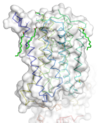Sandbox Reserved 1161
From Proteopedia
(Difference between revisions)
| Line 14: | Line 14: | ||
In the 7 transmembrane (7TM) domain, <scene name='72/721532/Mavoglurant_in_pocket/4'>Mavoglurant</scene> is in the 7TM domain pocket. Also, the lysozyme is attached to the intercellular region of the 7TM Domain. | In the 7 transmembrane (7TM) domain, <scene name='72/721532/Mavoglurant_in_pocket/4'>Mavoglurant</scene> is in the 7TM domain pocket. Also, the lysozyme is attached to the intercellular region of the 7TM Domain. | ||
| - | + | The variation can be seen in positioning of alpha helices. Class C has seemingly less space for mavoglurant to enter compared to Class A and F (Wu). The binding of mavoglurant is seen to be varied in different locations due to helix position (Dore). | |
| + | |||
| + | |||
== Function and Pathway == | == Function and Pathway == | ||
| + | |||
| + | It all begins with glutamate binding to the venus fly trap domain. The signal transduction goes across the cystine-rich domain to the 7TM. Next the dimerization of the 7TM occurs. This activates the Gq/11 pathway, which activates phspholipase Cβ. The active phospholipase Cβ performs hydrolysis on phosphotinositides and generates inositol 1,4,5-trisphosphate and diacyl-glycerol. This results in calcium mobilization and activation of protein kinase C. (Niswender, Colleen M..(2010). "Metabotropic Glutamate Receptors: Physiology, Pharmacology, and Disease." Annu. Rev. Pharmacol. Toxicol. Annual Review of Pharmacology and Toxicology 50.1: 295-322.) | ||
== Disease == | == Disease == | ||
Revision as of 02:22, 30 March 2016
Human metabotropic glutamate receptor 5 transmembrane domain
| |||||||||||


